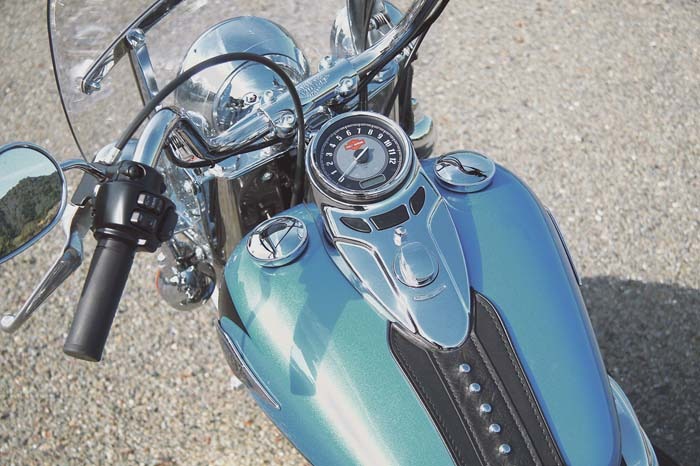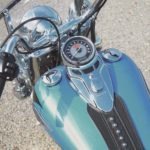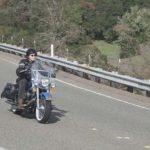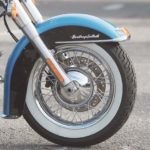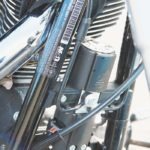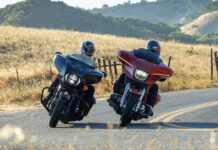Getting with the touring times
Vintage looks, contemporary upgrades
Throughout its entire tenure, dating back to 1988, the Heritage Classic has led something of a double life, essentially filling a transitional niche between two distinct platforms, the lean retro rigid-mount Softails and the dressed-up mile-hungry Touring models. There was no way around it. The Heritage drew the assignment of being the Softail model purpose-built for extended two-up travel while remaining true to its roots, and it managed that balancing act nicely for a good many years, effectively measuring up to the roadworthiness standards of a basic tourer for the most part while remaining to all appearances stuck in 1951. But then it began to slip, and that’s because while Harley-Davidson’s Touring models stayed current with the ever-increasing competence and amenities of the modern form, experiencing dramatic modifications in both 2008 and 2009, the Heritage Classic actually retrenched further into its retro identity in 2009 with extensive restyling that included a cat-eye dash, half-moon floorboards and oval brake pedal pad, none of which added to its bare-bones suite of touring features—and in the case of the floorboards, arguably detracted from it.
In that regard, 2011 represents a catch-up year for the model, owing to a few notable modifications brought to the Softail platform this year that benefit the Heritage in its touring personality. The first of these is the fitment of entirely redesigned hand control switch modules to the bikes. The new switches have a sleek appearance and a confident quick-click operation, and they use fewer wires making a handlebar swap an easier operation, but most importantly they add a pair of functions to the cluster. On the new controls, the starter switch doubles as a one-push hazard light switch, simplifying that procedure, and the headlight dimmer switch now also serves as a selector to toggle through the various functions of the odometer display on the dash without removing a hand from the grip. Secondly, the odometer window has been enlarged and the actual menu of information available for display has been expanded so that in addition to the odometer, two tripmeters, clock, and fuel range readout, there is now a gear selection display and—gasp—a digital tachometer. On a Softail. What’ll they think of next?
Thirdly and most significantly, an optional Security Package is available on all 2011 Softail models except the Cross Bones. This $1,195 factory add-on includes a Smart Security System, which is nothing new, and an antilock brake system, which emphatically is.
Just stop it
ABS has been available either standard or as an option on all Touring models since 2008, but bringing the system to the Softails had some unique challenges, not the least of which was finding space for the components within the constraints of the low-slung solid-mount frames without unduly detracting from their signature sexy simplicity. To pull that off, the designers went with a three-piece setup that conceals the electronic control unit in front of the rear tire, and the hydraulic control unit for the rear wheel behind the transmission. The HCU for the front wheel was positioned between the front frame downtubes above the voltage regulator, where it’s visible but not an eyesore. Aside from the single wire coming from the front wheel brake sensor, it’s the only telltale that the system is onboard.
I was naturally curious to discover how the ABS functions on the Heritage compared to the system on the Tourer models with which I have had a good deal of experience over the last three years, so I took advantage of a nasty wintry downpour (of which we’ve had no shortage in California this season). I let the pavement get good and soaked for about, actually, three days and set off to get all scientific with the bike. The test procedure consisted of getting the Heritage up to various speeds and slamming on the brakes, simulating a wild-eyed panic stop. As expected, at virtually any speed the rear wheel antilock engaged immediately, sending the characteristic whack-to-the-boot feedback through the brake pedal to indicate it had taken over stopping duties and was performing them more competently than I could under those circumstances. The front brake antilock, on the other hand, was appreciably more reluctant to kick in than I’ve become accustomed to in the past on Tourer models. I attribute that difference to the Heritage being equipped with a single front disc rather than the mighty dual Brembo setup of the Tourers, and thus not as capable of a quick lock-up—though it’s also possible that I’m just losing my fearsome grip strength from spending too much time poking at a keyboard. In any event, the bike came to a halt smartly on the slick asphalt every time without wavering from its straight-line course, which is precisely what it’s intended to do. The confidence inspired by having that kind of stopping performance on tap whether you ever need it or not is worth the price of admission.
The essential Heritage
With or without the optional Security Package, the Heritage Classic continues to fulfill its time-honored role as Milwaukee’s old-school bagger splendidly, proving for the most part as roadworthy and distance-friendly as any dedicated touring mount from Milwaukee. Even as the displacement of the Touring models has inched up so that a TC 103 is now standard on three models and optional on two others, and I’ve become accustomed to that added oomph in my recent reviewing duties, the familiar and ultra-reliable TC 96B of the Heritage is far from lacking for serious road work. It produces a lusty 92.2 ft/lbs of torque and virtually no vibration at any speed (and at this point in time, the once-annoying thumping of the counterbalancers has become oddly reassuring). The 6-speed Cruise Drive transmission is likewise bulletproof and keeps the bike motoring at arelaxed gait at freeway speeds. The broad windscreen provides excellent wind protection and the enormous heavily-studded saddlebags provide generous packing capacity. A big plush operator saddle, operator floorboards, plush passenger accommodations that include a fat pillion and sissy bar with a thick well-positioned backrest contribute as well, making this machine a creature of all-day comfort. The only practical feature lacking in its touring complement is some kind of locking device on the saddlebags.
From an ergonomic perspective, the combination of low-slung saddle, wide-spaced floorboards and easy-reach apehanger handlebar combine to position the operator in an optimal posture for both all-day comfort and lowdown look-at-me cruising. The Heritage seat height is a short 25.5 inches—comparable to that of the new Sportster SuperLow. Even with its relatively short travel, the Softail rear suspension absorbs the bumps proficiently even when fully loaded with passenger and gear, and actually provides a gentler ride than the slammed air suspension of the Touring platform’s top-selling Street Glide. Slow speed operation in urban traffic lots is a breeze, the well-balanced Heritage maneuvering nimbly with little effort. It helps in those operations that The Motor Company has resisted the impulse to put fatter rubber on the model even as the rear rubber on the Touring platform grew to 180mm and its similar stablemate, the Fat Boy, swelled to 200mm. The Heritage sensibly stays with a conservative and agile 150/80B16 (among Big Twins, only the Softail Deluxe’s MU85B16 has a narrower section). The only knock on the Heritage’s handling comes in the curves, where its restricted cornering clearance makes scraping a floorboard unavoidable under any aggressive cornering circumstance. With the addition of the outrigger half-moon units in 2009, the Heritage ended up with an aggregate right side/left side lean capacity that’s the shortest of any model out of Milwaukee including the aforementioned SuperLow.
Among the Heritage Classic’s most attractive features is the ease with which it can be adapted for riding in extremes of temperature or stripped down for boulevard presence. Hooking up the electrical pigtail for heated apparel when conditions turn frosty is a simple operation on the bike, one that requires only a screwdriver and a couple of minutes because of the ease of seat removal and the easily accessible battery terminals beneath. It’s also an easy and sanitary matter to thread the pigtail out at the rear of the tank for convenient plug in. With the vest and gloves wired in, and with theadmirable weather protection afforded by the windscreen, long rides in frigid conditions remain hospitable, and that’s the reason the Heritage has become something of a default winter ride review mount for me over the years.
At the other temperature extreme, or merely for looking retro-cool around town, it’s also a simple matter to flick a pair of spring clips and pop the quick-release windscreen off its docking points, fully exposing the dashing chrome appointments of headlamp, nacelle and handlebar, and letting in the breeze.
Forward-looking statements
Where the Heritage Classic will go from here in staying current with touring technology and remaining a viable old-school alternative to the more contemporary distance rigs on the market is something worth speculating on in light of the innovations brought to the CVO Softail Convertible over the last two years. What we know from that model is that Milwaukee has both an electronic throttle system and ultra user-friendly cruise control setup adapted for the Softail platform, and it’s reasonable to suspect that the Heritage will benefit from those developments at some point in the near future. It’s also not farfetched to suspect that the Heritage might ultimately benefit from Harley-Davidson’s recent development of a locking snap setup for soft saddlebags and finally bring some security to that end of things. We can only hope.
The base price for the 2011 FLSTC Heritage Softail Classic is $16,999. As shown here in two-tone Cool Blue Pearl/Vivid Black trim with Chrome Profile Laced wheels and the Security Package is $19,399.


